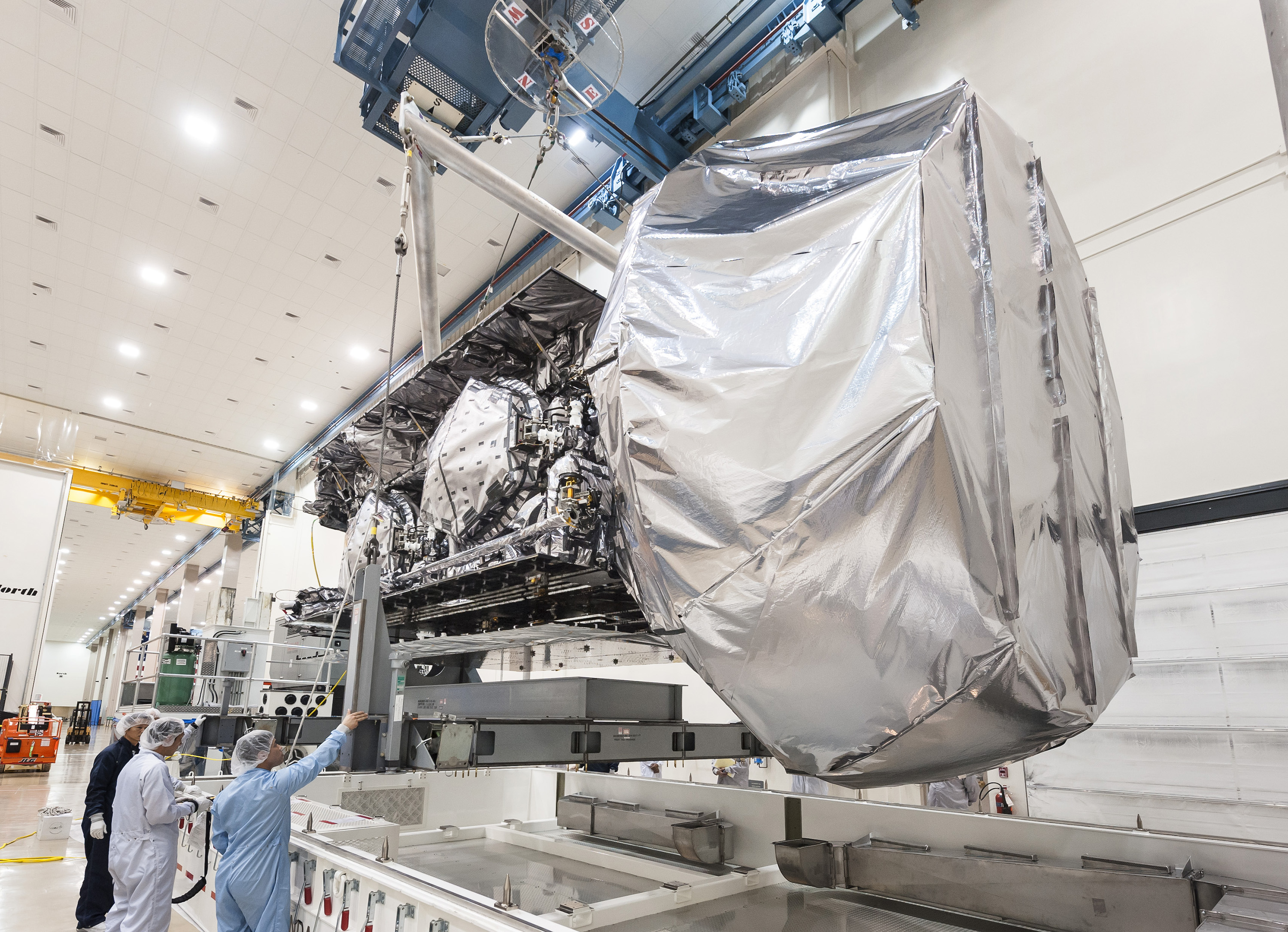
The third in a five-ship fleet for a next-generation, narrowband tactical military satellite communications system is nearly ready for a scheduled nighttime launch attempt next week. United Launch Alliance (ULA) will kick off their new year from Atlas Space Launch Complex-41 at Cape Canaveral Air Force Station in Florida, where crews are making final preparations to deliver the U.S. NAVY’s latest Mobile User Objective System satellite, identified as MUOS-3, into a geostationary orbit over the Atlantic Ocean, over 22,200 miles high.
The Lockheed Martin-built satellite, which is ULA’s heaviest Atlas-V payload to date at nearly 7.5 tons, is currently scheduled for liftoff on Jan. 20 at 7:43 p.m. EST, with a 44-minute launch window available until 8:27 p.m. EST. Current weather forecasts call for a 60 percent chance of favorable conditions at the launch site that evening.
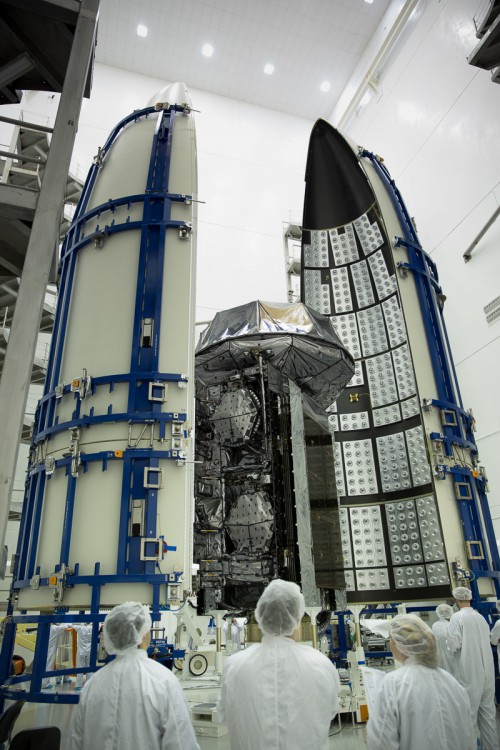
ULA completed their MUOS-3 Flight Readiness Review (LRR) this morning, with no issues reported and a unanimous “GO” given to proceed toward liftoff. The 45th Space Wing, in charge of the Eastern Range, will hold their own FRR later today to assure everything is ready on their end to support next week’s scheduled launch attempt as well. All other reviews have been completed, and crews will spend today and Saturday finishing up with close-out activities, such as installing ordinance, ahead of transporting the Atlas-V rocket to its seaside launch pad.
MUOS operates like a “smart phone cell tower in the sky,” supporting a worldwide, multi-service population of users in the UHF band, providing increased communications capabilities to smaller terminals while still supporting interoperability with legacy terminals. The new military SATCOM system will, for the first time, give MUOS Wideband Code Division Multiple Access technology users beyond-line-of-sight capability to transmit and receive voice and data using an Internet Protocol-based system, giving users greater mobility, higher data rates, and improved operational availability.
The size of MUOS is a result of the nature of the size of the UHF waveform, and its weight is due to the fact that—besides requiring bigger hardware for UHF—it will be going to GEO for an expected 15 years of operation, and so it needs a lot of fuel.
MUOS is an IP-based communications protocol based on 3G, which will give military users on the move more communications capability over existing systems, including simultaneous voice, video, and data—similar to the capabilities experienced today with smart phones, providing users with 10 times more communications capacity.
MUOS-3 arrived at Cape Canaveral, Fla., on a C-5 Galaxy transport aircraft via Lockheed Martin’s Sunnyvale, Calif., facility and nearby Moffett Field on Nov. 5, 2014, courtesy of the 60th Air Mobility Wing of Travis Air Force Base. After completing post-shipment testing, technicians fueled the satellite and encapsulated it inside the Atlas-V’s 5.4-meter (17.7-foot) bullet-like payload fairing on Dec. 18. The payload was hoisted vertical and mated to the Atlas-V rocket on Jan. 11, representing one of the final major steps in preparation for its upcoming launch.
ULA’s workhorse Atlas-V will fly MUOS-3 in its most powerful “heavyweight” 551 configuration, employing the added power of five strap-on Aerojet Rocketdyne solid-fueled boosters to deliver the NAVY’s 15,000-pound satellite to GEO, more than 22,000 miles above Earth. ULA has launched 51 missions over 12 years on their Atlas-V fleet of rockets—all successfully—but only four of those missions required the 551 configuration: New Horizons to Pluto in 2006, JUNO to Jupiter in 2011, and MUOS-1 and MUOS-2. Once the rocket’s first stage and booster’s are spent, the vehicle’s single-engine RL-10C Centaur upper stage (its second flight) will give MUOS-3 the final push it needs to enter its intended orbit. Once the on-orbit testing for BUS systems and payload systems is completed, the satellite’s operation will be handed to the NAVY to put their satellite into its final on-orbit position over the Atlantic Ocean (MUOS-1 and MUOS-2 are located over the Pacific).
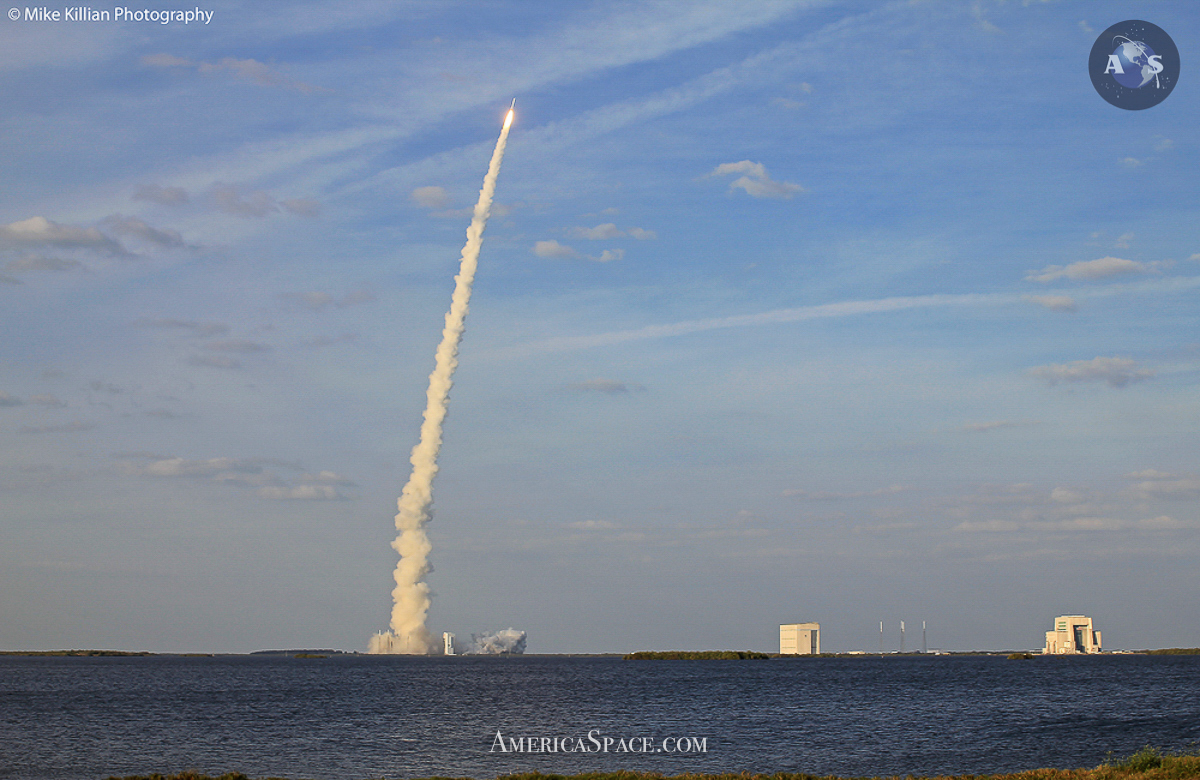
A total of five MUOS satellites will make up the MUOS fleet, but only four will actually be required to put the whole system into action. MUOS-4 is scheduled to fly sometime in August later this year, with the fifth and final MUOS to launch in 2016 to serve as an on-orbit spare should any of the first four lose their capabilities. The entire MUOS constellation is expected to become fully operational in 2016.
When MUOS was originally envisioned, the NAVY reserved sufficient bandwidth to co-locate an additional satellite at each of the four on-orbit locations as well, so there is certainly potential for the NAVY to double their MUOS capability should the government ever need it. According to the NAVY, various analysis and reviews will begin in the next year or two to determine what will come after MUOS, but there are no plans for after MUOS just yet.
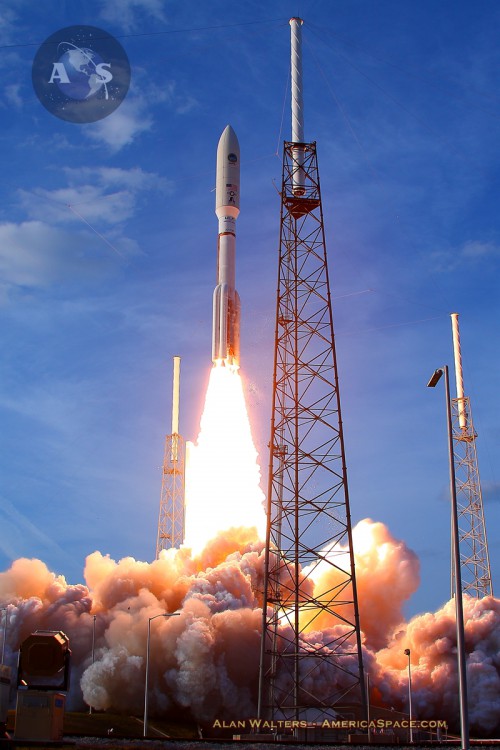
Original plans called for the first MUOS to launch by 2010, but budgetary adjustments made in response to the Iraq war led to a two-year delay. MUOS-1 launched on Feb. 24, 2012, followed by MUOS-2 on July 19, 2013, and in the time since both have demonstrated new capabilities, especially in the Arctic, an area previously beyond the coverage of UHF satellites and growing in interest for transportation and natural resources exploration above 65 degrees north latitude. In the past year MUOS successfully connected users near the Arctic poles during independent testing by Lockheed Martin, and during the U.S. Navy’s 2014 Ice Exercise (ICEX) and the U.S. Coast Guard’s Arctic Shield 2014.
The MUOS satellites seek to offer global satellite communications narrowband (64 kbits/sec and lower) connectivity for use by U.S. and allied forces, with an ultra-high frequency range from 300 MHz-3 GHz. When fully functional, it will replace the legacy UHF Follow-On (UFO) satellite network—the first of which was launched back in March 1993—before the latter system reaches the end of its operational service. MUOS will provide new capabilities and enhanced mobility, access, capacity, and quality of service, with particular emphasis upon mobile users, such as aerial and maritime platforms, ground vehicles, and dismounted soldiers.
By operating in the UHF frequency band, which is lower than that used by conventional cellular networks, MUOS will provide U.S. and allied warfighters with the tactical ability to communicate in “disadvantaged” environments, including heavily forested areas where higher-frequency signals would be otherwise impaired. Even troops in buildings with no satellite access are expected to see an increase in communications capability.
“This third MUOS launch is another major step toward achieving a fully operational MUOS end-to-end capability by 2016,” said Navy Capt. Joseph Kan, the MUOS program manager. “The Navy, in close collaboration with the Army, Air Force and our industry partners, is bringing the future of worldwide mobile satellite communications into reality for the United States and potentially allied nations.”
The infrastructure to both fly the MUOS satellites and control access of a user’s communications is managed from the ground. Operationally, information flows to the satellites via UHF WCDMA links, and the satellites then relay the information to one of four ground sites located in Hawaii, Virginia, Italy, and Australia via a Ka-band feederlink. These facilities identify the destination of the communications and route the information to the appropriate ground site for Ka-band uplink to the satellite and UHF WCDMA downlink to the correct users. MUOS will also provide users access to select Defense Information System Network voice and data services.
FOLLOW our MUOS-3 “Launch Tracker” for regular countdown updates and live launch coverage!
– Written by Mike Killian and Ben Evans
Atlas-V MUOS-3 Encapsulation
Atlas-V MUOS-3 Encapsulated Payload Mate
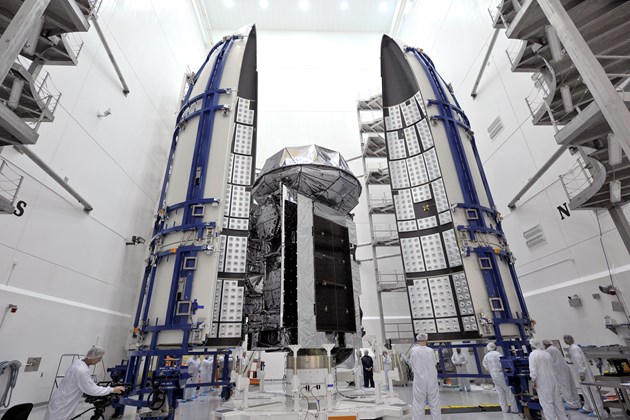
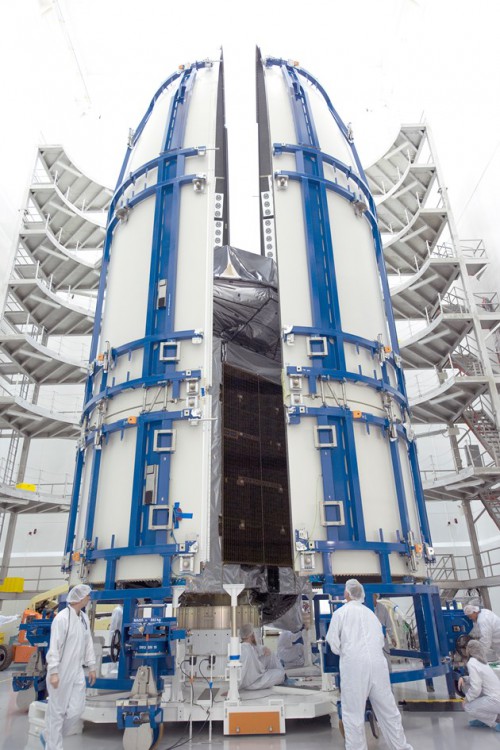
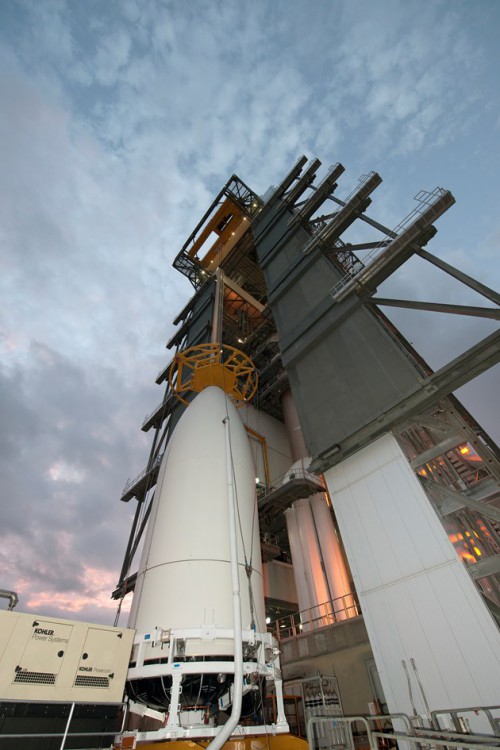

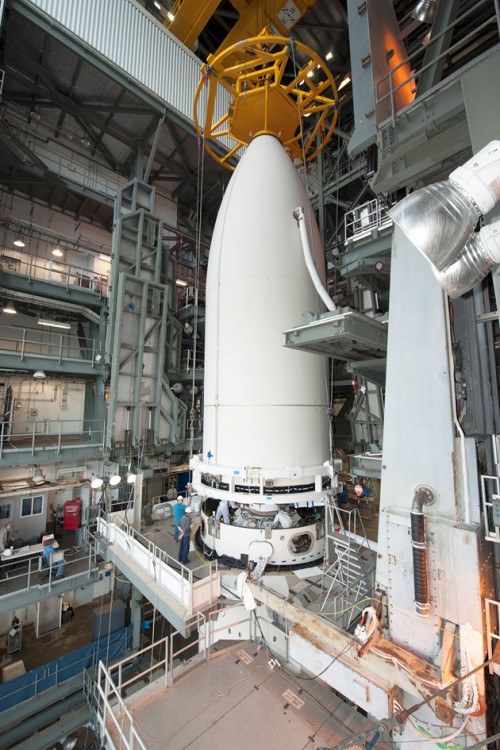
Want to keep up-to-date with all things space? Be sure to “Like” AmericaSpace on Facebook and follow us on Twitter: @AmericaSpace
Missions » MUOS » MUOS-3 »





Heaviest ULA payload ever? Are you sure about that? What about Orion EFT-1, or some of the NRO payloads carried aloft by the Delta IV Heavy?
Well, Mike, I see that you have corrected your headline to “Heaviest Atlas-V Payload” without bothering to note the correction.